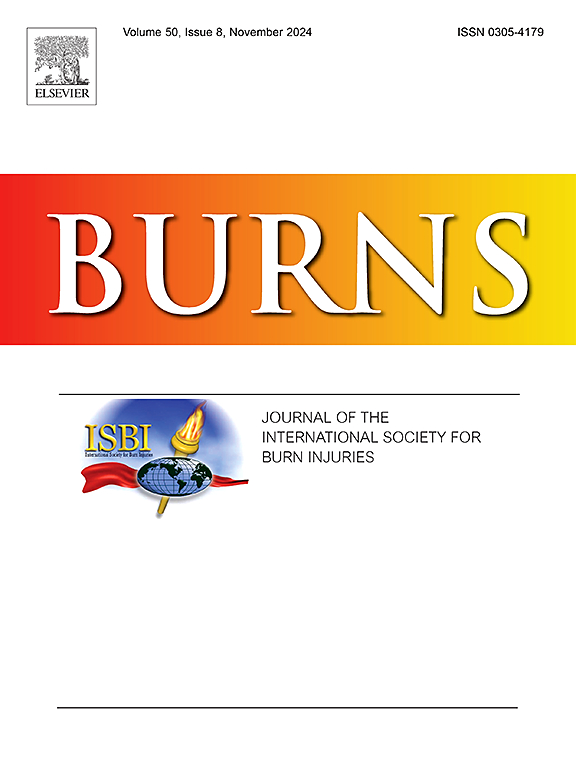Increased prehospital mortality in patients with combined burns and trauma in Canada: Analysis of a provincial trauma registry database
IF 3.2
3区 医学
Q2 CRITICAL CARE MEDICINE
引用次数: 0
Abstract
Introduction
The combination of burns and non-thermal trauma may have a synergistic effect on mortality. Our objective was to determine if burn patients with concomitant trauma are at increased risk of mortality in both the prehospital and in-hospital settings.
Methods
Data were collected from a population-based provincial trauma registry (2001–2019). Characteristics and outcomes of patients with trauma/burns were compared to isolated burn patients using t-tests, chi-square analysis and Fisher’s exact tests. Risk ratios (RRs) were calculated to evaluate the impact of concomitant trauma on mortality, stratified by % total body surface area (TBSA) and injury severity score (ISS). Firth's penalized maximum likelihood estimation (PMLE) approach was used to fit multivariable logistic regression models to the outcomes of prehospital mortality and in-hospital mortality.
Results
Of 436 burn patients, 29.8 % (130/436) had combined trauma/burns. Prehospital mortality in the trauma/burns group was 57.7 % (75/130) versus 43.1 % (132/306) in isolated burn patients. Prehospital mortality risk was highest in trauma/burn patients with % TBSA ≥ 70 (RR 3.87, 95 % CI 2.99–4.99) or ISS ≥ 25 (RR 2.49, 95 % CI 1.84–3.36). Concomitant trauma was associated with increased odds of prehospital mortality (OR 2.42, 95 % CI 1.27–4.69), but had no impact on in-hospital mortality.
Conclusions
Prehospital mortality was increased in patients with combined burns and trauma.
加拿大烧伤和创伤合并患者院前死亡率增加:对省级创伤登记数据库的分析
简介:烧伤和非热创伤的结合可能对死亡率有协同作用。我们的目的是确定合并创伤的烧伤患者在院前和院内是否有更高的死亡风险。方法:数据收集自以人群为基础的省级创伤登记处(2001-2019)。采用t检验、卡方分析和Fisher精确检验比较创伤/烧伤患者与孤立烧伤患者的特征和结局。计算风险比(rr)以评估合并创伤对死亡率的影响,并按%体表面积(TBSA)和损伤严重程度评分(ISS)分层。采用Firth的惩罚最大似然估计(PMLE)方法对院前死亡率和院内死亡率的结果拟合多变量logistic回归模型。结果:436例烧伤患者中,29.8 %(130/436)合并创伤/烧伤。创伤/烧伤组院前死亡率为57.7% %(75/130),而孤立烧伤患者的院前死亡率为43.1% %(132/306)。TBSA≥ 70 (RR 3.87, 95 % CI 2.99-4.99)或ISS≥ 25 (RR 2.49, 95 % CI 1.84-3.36)的创伤/烧伤患者院前死亡风险最高。合并创伤与院前死亡率增加相关(OR 2.42, 95 % CI 1.27-4.69),但对院内死亡率没有影响。结论:烧伤合并创伤患者院前死亡率增高。
本文章由计算机程序翻译,如有差异,请以英文原文为准。
求助全文
约1分钟内获得全文
求助全文
来源期刊

Burns
医学-皮肤病学
CiteScore
4.50
自引率
18.50%
发文量
304
审稿时长
72 days
期刊介绍:
Burns aims to foster the exchange of information among all engaged in preventing and treating the effects of burns. The journal focuses on clinical, scientific and social aspects of these injuries and covers the prevention of the injury, the epidemiology of such injuries and all aspects of treatment including development of new techniques and technologies and verification of existing ones. Regular features include clinical and scientific papers, state of the art reviews and descriptions of burn-care in practice.
Topics covered by Burns include: the effects of smoke on man and animals, their tissues and cells; the responses to and treatment of patients and animals with chemical injuries to the skin; the biological and clinical effects of cold injuries; surgical techniques which are, or may be relevant to the treatment of burned patients during the acute or reconstructive phase following injury; well controlled laboratory studies of the effectiveness of anti-microbial agents on infection and new materials on scarring and healing; inflammatory responses to injury, effectiveness of related agents and other compounds used to modify the physiological and cellular responses to the injury; experimental studies of burns and the outcome of burn wound healing; regenerative medicine concerning the skin.
 求助内容:
求助内容: 应助结果提醒方式:
应助结果提醒方式:


